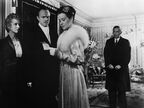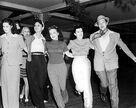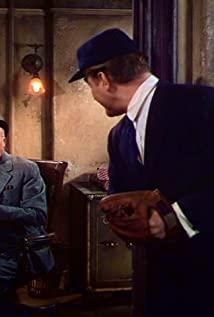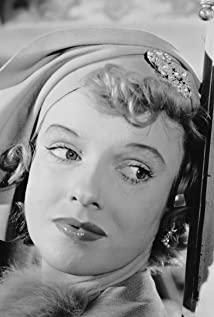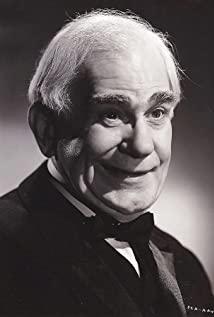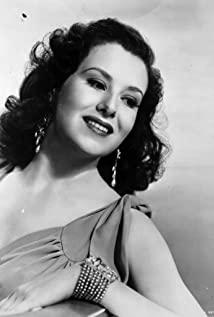1. Depth of field lens
The depth-of-field lens that Kane was handed over to the banker’s upbringing in his childhood is the most talked about in many years. The large-depth-of-field lens is used here to make everyone in the picture clear, and the role of each character is changed through the composition. It's clear at a glance. First, the mother and the banker are on the same side, the closest to the camera, and the two directly occupy one-half of the content of the frame, sitting dignified and decently signing the handover documents. Kane's father was far away from the camera, standing by the door frame, on the left side of the frame, and his clothes were in sharp contrast with the two in front of him. He was sloppy and casual. In the film, he is very opposed to the fostering of Kane to others, but no one listens to him, and he has been in a hesitating and embarrassing position. Although the father is standing, the lens can basically cover his whole body, but it occupies a much smaller proportion in the frame, reflecting the gap in family status. Compared with mothers, fathers have no right to say what to say about their children. Little Kane is the farthest away from the camera, even outside the house, but the audience can still clearly see him playing happily in the white snow, ignorant of his own destiny, but they have no choice.
Then a cut mirror, the mother watched little Kane play for the last time. With the short focal length and large depth of field lens used at this time, the mother’s face is zoomed in closer to the audience, while the father is not far away from the mother, but the visual effect is reduced a lot, as if it is attached to the mother’s back, the short focal lens makes three people. There is an obvious disparity in the proportions of shapes and sizes. The close-up of the mother's face is even slightly deformed, forming a sharp visual effect, reflecting the mother's coldness towards the child, causing the female image in Kane's memory to be blunt and distorted.
In the middle age, directors often used large depth-of-field shots to reflect the relationship between Kane and the people in the newspaper. There are many such shots. The foreground of the main characters in the screen, Kane is usually located in the center of the frame. In this scene, there are 4 main characters. Li Lan and Bernstein are standing on Kane's left, their eyes follow Kane and look towards Mr. Carter who is closest to the camera, only half of his back. Kane's eyes led the line of sight of the entire lens. The three people stared at the same time, oppressing Mr. Carter, and accentuating Kane's momentum. The crowd behind were in the vision of the picture, and they stood up and saluted when they welcomed Kane’s arrival. Although some people did not know Mr. Kane’s appearance, it is not difficult to see that Kane was already very famous and aura in his youth. It was a stage of being very arrogant and triumphant. Because he got rid of the pain of childhood poverty, he changed from being controlled by others to a role of controlling others.
This shot that embodies Susan's suicide also uses a large depth of field to reflect the deep relationship of the space, and after careful scene scheduling, a large amount of information is contained in a picture. First of all, the medicines and glasses in the foreground imply the direct cause of Susan's suicide. The light is bright and clear. Susan is lying on the bed and should be in the middle shot. The light is dim and dim, implying that she is in a painful and dark stage. Vision Kane rushed into the room to make the audience's attention shift from the medicine bottle to the person, implying that Kane was the source of Susan's real pain. The director used a large depth of field and precise scene scheduling to tell the audience Susan with a single shot. At the same time, it leaves the audience with plenty of room for interpretation.
In his old age, Kane, all the people he loved had left him, although he had wealth and power, he was still alone. He smashed something in the house and slowly walked out of the room. A short focal length lens was used here to clearly show not only Kane but also the people around him. The wide-angle lens made the amount of information in the picture larger and the content changed. Many, the audience can clearly see that the focus of the picture is on Kane from the standing and focus of everyone around him. Although everyone paid attention to him and looked up at him, no one could get close to him, and no one could talk to him. Kane walked past the crowd, and people gave way to him one after another. It can be seen from this that although he is highly regarded and respected by others, no one is cute and lonely. It implies his whole lonely destiny. He constantly loves others in his own way, but in fact he hurts others and gradually changes with others. The line drifts away.
Especially for characters in dialogue, or if they want to highlight someone’s image, usually the director will use a telephoto lens with a small depth of field. The large depth of field lens will clearly show all the content in the frame, and the audience’s attention may be more than just limited. The protagonist. And Director Olson also used this different method to better show the relationship between Kane and the people around him, and it is also in line with the premise that his stories are reproduced from the mouths of others. Kane's image is also It needs to be presented more three-dimensionally in a complex and complete society.
The lens with small depth of field is indeed helpful for guiding the audience to pay attention to a certain character, just like the dialogue lens in "Elephant Sitting on the Floor".
It is also to show a deep relationship. Director Hu Bo uses a telephoto lens with a small depth of field. Only the grandfather is clearly visible in the picture. The audience can observe his facial expressions in detail, while his son and daughter-in-law are very blurred in the back. , Can only use exercise to remind the audience that they are still occupying the frame. This method allows the audience to understand the director's intentions at a glance, and follow the director's ideas to focus on the focus of the frame. The shaping of the characters is more reflected in his own actions and expressions.
When Huang Ling was talking with the deputy director, the lens kept zooming. When two people were on the same side of the frame, the focus shifted to whoever spoke. There was even a little discomfort when watching because the two people were too close. At this time, the use of a telephoto lens will deliberately pull away the characters, making the picture very distorted. Many critics think that this shot is very exciting and very clear, but as an ordinary audience, you may feel that the director has a strong sense of penetration and is too different from the actual experience, which affects the perception. Of course, he does not deny that this method is very capable of showing. The details of the actors can quickly let the audience "understand" the role.
So in comparison, Orson Wilson uses a lens with a large depth of field to better reflect the sense of depth of the space, and from the character scheduling in the frame to reflect the status and role of the character, shape the image of the character, and let the audience appreciate the long lens. Interpreting the information points you care about is an excellent control and application of the depth-of-field lens.
2: Long shots and montages
"Citizen Kane" still uses a large number of long-lens shooting techniques in its only two hours of less than two hours.
It also started with the shots of Kane in his childhood. At first, I shot the middle shot of Kane playing in the snow. The light was bright and the characters were vivid and lively. Then a zoomed shot, the mother appeared from the lower left corner of the frame, and then brought out the three main characters in the house: mother, banker and father. Then as the mother walked into the house, the camera continued to extend, the figure of Kane. It gradually becomes smaller, and the dim, dilapidated environment inside the house gradually appears, and it also forms a sharp contrast with the scene outside the window, as if the snowy sky outside and Little Kane are just a painting on the wall or a picture on the TV. The scene is the same, incompatible with the atmosphere in the house, and the contrast is sharp, which even hints at the abrupt end of his beautiful childhood. As the mother and the banker sat down at the table, the camera movement stopped and fixed, showing a series of documents signed to sell Kane. This long shot uses the obvious contrast between the two scenes outside the window to show the mother’s unfeeling towards Kane and Kane’s foreshadowing of the whole life tragedy caused by the lack of childhood. His wrong perception and treatment of women are also affected. The influence of the distorted mother-child relationship in childhood.
Both Susan's key appearances were shot with almost the same group of long shots, which was deliberately repeated editing. The camera first shows a close-up on Susan’s billboard, then the camera moves upwards, and the "Susan Show" billboard lit up in the rain indicates that Susan has become famous, but in the thunderstorm environment it also implies that Susan is not. Happy, she is very painful because of her singing career and Kane's death. This is not the environment and life she wants. Then the camera moved forward to the glass window on the roof, through which Susan could be seen sitting alone. Then the camera went through the rain and "passed through" the glass window to enter the interior of the house. At this time, the camera did not actually pass through the glass window, but formed a coherent long shot through the wall through coherent editing in the later stage. Break the audience's sense of substitution. The audience followed the camera into the room, and the focus was on Susan, as well as the conversation between Susan and the servants and reporters. A shot can clearly explain Susan’s identity, current situation, mood, environment and state, and make the audience feel like a voyeur, sneaking into Susan’s house from the rainy night to listen to their conversation, suggesting Susan at this time. Shan is in a sad time, and she doesn't want anyone to disturb her.
The newspaper celebrating the achievement is also a very well-known long shot with depth of field. The foreground here is that Li Lan is presenting to Roberts his concern about Kane from the newspaper. The two are on the left and right sides of the frame, with the dancing girl in the middle. Kane is dancing happily. The whole scene is dynamic, quiet, joyful and worrying. In this long shot with a large depth of field, the audience can interpret the carnival dance behind Li Lan’s concerns, indicating that Li Lan’s prediction will definitely come true, and Kane will eventually Defeated by one's own domination and self. Even though there was a brief change of camera position in the middle of the camera, the positions of the two in the frame did not change, and the dance of Kane and the dancers was clearly reflected from the window behind the middle. The content in such a long shot is rich and complex, and the audience can read different elements in different viewing periods, and when all the information is integrated, they will understand the director's ingenious intentions.
In addition to the use of longer long shots, the film also uses a large number of montage editing methods to perform a large number of rapid cuts. The most obvious is that the film first uses newsreels to quickly recall Kane’s life and every director. When reading paper materials (newspapers, books, letters) for time-space conversion and rapid advancement.
The opening director used a slide show-like method with narration to show the audience Kane’s surface image in the eyes of the public. The rapid editing of the scenes that flashed by made the audience overwhelmed, leaving only the basic impression of his wealth and complexity. . Using this montage editing method can simulate the texture of the news, let the audience immediately feel the surface image of Kane in the shortest time, and also create a sharp contrast for the contrast of his life later, reflecting that a person is in the public There is a big gap between the state shown in front of him and his true state. People only care about what they want to know, and their knowledge of someone fluctuates with the direction of public opinion.
There are quite a lot of scenes using paper materials to ingeniously change time. From the beginning, the banker read letters to Kane on every birthday. The letters were all about his work or business requirements. Three letters The letter went directly to him becoming a young man; then when Kane ran his own newspaper, bankers often read news about his business losses from different newspapers. Through the newspaper reports on Susan, it is obvious that she has gradually become famous from being unwelcome. Spatiotemporal alternation in the form of words is not only a secret echo of the career of the Kane Times newspaper tycoon, but also a sharp contrast between the cold words and the major ups and downs of life, indicating that news and news are only temporary talks in the mouths of the masses. The topic is a major turning point for the parties involved.
This film can be called a template of the perfect combination of montage and long shots. At the beginning of the film, a large number of montages show Kane in the eyes of the public. Later, when Kane’s story is really told, long shots are used to create characters. Here There is a sharp contrast. And even in the later long shots, the inside of the lens is montaged, the objects and people are reflected, the contrast between movement and stillness, the regular movement of the lens, showing different environments, indicating different situations of characters... The director is in The montage thinking is also used in the arrangement, instead of telling Kane's life in order, but showing different periods through different people and different perspectives, and finally stitching together a complete character image. This is also a manifestation of nonlinear montage thinking. It is true that most of the shots in this film are very good long shots, and the overall structure and interpretation of the film all reflect the montage thinking.
Three: shooting angle
The position and situation of the character can be clearly seen from the angle of shooting the character.
Compared with other movies, "Citizen Kane" has fewer head-up shots, and a lot of looking down and looking up to show the status of the characters. When Kane was picked up by the banker when he was young, he used an absolute top-down lens to show his situation, and he was surrounded by adults, and the location of the camera seemed to be one of the adults. Look It can be concluded that at this time, the little Kane has lost his childhood happiness and is suppressed and controlled. In the same way, when he treated Susan in middle age, it was almost the state of the young adults. They were all in a condescending position. Susan was losing his temper at this time, and Kane walked directly over and Susan was buried in Kane. In the shadow of, a bird's-eye view shows that Susan is just a puppet controlled by Kane, always in a controlled situation. The alignment of these few looking down shots is a good demonstration of Kane’s psychological transformation. From being manipulated at the beginning to manipulating others at the end, it is the consequence of the lack of a good childhood, which makes him unable to love selflessly correctly. Others only get the pain and departure of others.
Similarly, when Kane grew up and became powerful and powerful, he was almost always represented by looking up at the camera, and in contrast with the looking down shot when he was a child, he got rid of the oppressed position and became a person looking up at others. Awe-inspiring person with a tall and majestic image, but also implies that he will end up with nothing because of his selfishness and manipulative desire.
After the scandal between Kane and Susan was revealed, he returned to the newspaper to quarrel with Li Lan. Here the camera is lowered to the lowest level, almost close to the floor, giving the two men an absolute looking up lens. However, Kane at this time should be an embarrassing stage of being criticized. Looking up at the camera not only has an ironic effect, but also highlights that Kane still maintains his strong self-esteem even at this time, without realizing it. My own problems led to the current consequences. Li Lan has been very angry and accused Kane, but Kane ignored it. Looking up at the camera here gives a panoramic view of Kane's entire figure, implying that this character is just stubborn and empty and tall, but in fact he is just one heart for himself, and he does not reflect on the evil consequences of his own hands.
In addition to looking down and looking up, there are also enough head-up shots in the film. For example, when watching Susan’s performance, the director used a front-up head-up shot to take close-ups of Kane’s facial expressions. Using the head-up lens allows the audience to better capture the actors’ Facial expression. Here’s close-ups of Kane interspersed with Susan’s performance. It can be seen that the director uses light and shadow to highlight Kane’s eyes. From his eyes, I can see that Kane is more than just enjoying a song performance. , His slightly frowning serious expression reflects that he attaches great importance to the effect of Susan's performance, and is also very fancy to the audience's response. The director gave Susan both the perspective and the panorama, and the close-ups given to Kane. It seems that the camera positions are also on Kane’s side, as if the focus of the whole show is not on Susan’s interpretation, but on Kane's emotions and Susan's performance are also in Kane's hands, and Susan is just a vase manipulated by him.
The director constantly hints at the transformation of the character’s status by changing the camera angle of the character. From being captive to manipulating newspapers, manipulating public opinion, manipulating his lover, it seems that he has compensated for his painful past, but he is rebelling against the dictatorship. Becoming a despot, until everyone left, he picked up the crystal ball and thought of himself in his childhood, only to truly realize that his life's resistance would ultimately end in failure.
Four: Conclusion
Not only the few aspects mentioned above, "Citizen Kane" is an absolute pioneer in the composition of the picture, the handling of the relationship between sound and picture, and the movement of the camera. All audiovisual language skills are In order to show the audience the growth and decline of a proud business tycoon, through the reminiscences of different people, and the search for the truth about the "rosebud", the camera told the audience "no entry" from the very beginning, as if it was Kane. To the people around him, to the society, and to the audience is the same. Although his interpersonal relationship is countless, no one can really walk into his heart because of his psychological closure, and the director leads the audience to ignore this. Layered fences, step by step into the life of this legendary man, searching for the answer to his life. After questioning many people, the author finally failed to find the secret of the rose bud. The camera continuously pulled upwards, showing the whole picture of Kane’s house. It was filled with various statues and valuables. It was magnificent and incomparable, and people looked abnormal in it. The whole room was filled with objects, and it seemed impersonal and lifeless. This was also a reflection of Kane’s own image. In the end, the rosebud sled board was thrown into the stove symbolizing power as rubbish by the workers and burned. In addition to the audience, no one can know this secret anymore. The rose bud merely represents Kane’s childhood, and his entire life has been tracing and compensating for the missing childhood.
Kane grew up from an early age, picked up the crystal ball in his later years and recalled his childhood. The movie shots started from "No Entry" to the end of the story and returned to the "No Entry" slogan, all like Villeneuve in " What is conveyed in "Arrival" is a kind of loop, a kind of reincarnation, both in content and form. We can’t remedy the pain of the past, so in the process of growing up, we must avoid becoming the “bad guy” before and let others bear the pain we have suffered before. At the same time, one cannot truly understand another person, that is, no one has real empathy. Whether you listen to different stories of one thing through Rashomon, or listen to different people telling his whole life like Kane, you can’t discover the real secrets of others. Everyone’s heart is a "no entry "In the castle, the secrets and truths inside will always only be known to me.
View more about Citizen Kane reviews



